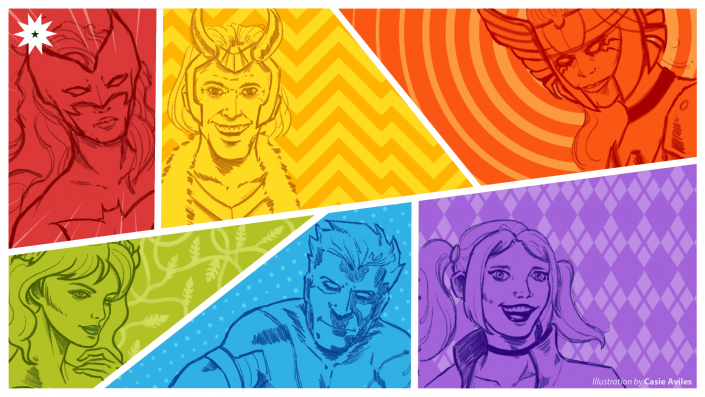
Superheroes, be it on-screen or on printed media, have been the childhood idols of a great many throughout the decades. They have come to represent our desires, dreams, and values. However, this connection between superheroes and the audience becomes muddy when these figures become alien from one’s lived-in experiences.
While LGBTQ+ characters in comic strips have existed as far back as the 70s, representation of the community in comic books has been heavily censored. It wasn’t until the 90s when queer characters started to trickle into mainstream comic books. Though, visible representation does not necessarily mean good representation.
Only recently, comic book publishing giants DC and Marvel released their first-ever LGBTQ+-inspired anthologies to celebrate this year’s Pride Month. DC Pride and Marvel’s Voices: Pride are stories that center queer superheroes—bringing a different kind of courage to their pages.
DC Pride
A diverse set of writers and artists brought these stories to life with vigor and respect for the characters and their identity, creating this sundry collection of queer narratives. From the reflective and gothic atmosphere in the tale of Batwoman’s qualms with femininity, to the spritely hodgepodge of color and personality of the Poison Ivy-Harley Quinn amorous duo—such diverse stories and imagery appropriately capture the essence of Pride.
However, it is quite dispiriting that more prominent characters like Wonder Woman—who is canonically bisexual in some reincarnations—don’t get a mention or even a special artwork panel like Midnighter and Apollo or Sojourner “Jo” Mullein. It is unclear whether it’s an attempt to deny her queerness or merely to give lesser-known characters a chance. Either way, her presence was sorely missed.
Admittedly, some fighting scenes weren’t as dynamic and fluid as your typical comic book action sequence. The art for every panel, however, consists of vibrant figures and polished artworks. It simply oozes with style and personality that helps the reader immerse themselves in the DC Universe.
One noteworthy similarity across all stories is the nuanced approach to telling queer narratives. There were stories—like Pied Piper roaming the streets of Central City—where we just follow these superheroes during their normal routines, grounding the larger-than-life elements of the comics in the inherent humanity of queerness. After all, the best representation is one that veers away from tokenizing the subject and instead reflects both complex and mundane realities.
That’s not to say that narratives dealing with sexual orientation, gender identity, gender expression, and sex characteristics (SOGIESC) should be overlooked. As it happens, some of the stories, such as the original Green Lantern Alan Scott’s late coming out, managed to deal with SOGIESC topics and other important issues like homophobia.
What DC Pride lacks in flair, it makes up for with mostly refined storytelling—one that uplifts the LGBTQ+ community to new heights.
Rating: 3.0/4.0
Marvel’s Voices: Pride
As with DC Pride, Marvel’s Voices: Pride consists of stories produced by different writers and artists, creating a smorgasbord of color and identity that is Marvel Pride. You get to witness the debut of Somnus or enjoy old favorites like Iceman, Mystique, and Destiny reclaiming their often-overlooked identities.
While most stories are brief, Marvel’s Voices: Pride has a more inclusive and lighthearted approach, involving chance queer characters without seemingly cheapening the experience. Despite the lighthearted nature of this anthology, the tales had depth and can at times be soul-stirring. It even dealt with pressing concerns faced by some members of the LGBTQ+ community, such as bisexual erasure and common misconceptions about trans individuals.
What actually cheapened the experience was the inclusion of 10 pages from Alpha Flight #106 released in 1992 and the timeline of queer narratives throughout Marvel’s publication history. While it’s touching and sweet, it seems to divert the reader’s attention from the decades-worth of censorship and erasure of the LGBTQ+ community in the Marvel Universe. They could have instead created entirely new queer narratives or provided more depth to some of the stories found in this anthology. In the end, it leaves a bad taste as the endeavor seems misplaced and can be misconstrued as pretentious and self-serving.
In some instances, the art feels lackluster, occasionally posing the characters in awkward and unrealistic proportions and using flat colors that leave the panels lacking depth and weight. But at its best, the art can be animated, dynamic, and even drop-dead gorgeous—capturing the magical and fantastical nature of the Marvel Universe.
Despite its shortcomings, Marvel’s Voices: Pride certainly feels like a celebration of queerness and individuality. It’s a welcome reminder that if the mightiest of heroes can love who they choose to love, so can we.
Rating: 3.0/4.0
Pride is a celebration of triumphs and the acknowledgment of past tragedies. If there’s one thing the reader must take from these two anthologies, it’s that the LGBTQ+ community is fighting for the same things that our beloved heroes are—acceptance, unconditional love, and respect.
To see our favorite superheroes go through the same rollercoaster of emotions and experience the same setbacks and hurdles that real queer people face brings a sense of comfort—a feeling that we are far from alone in this struggle.
DC Pride and Marvel’s Voices: Pride prompts the world to start seeing the LGBTQ+ community for what it truly is—a community of human beings. Truly, these anthologies are monumental firsts but also hopefully not the last.
